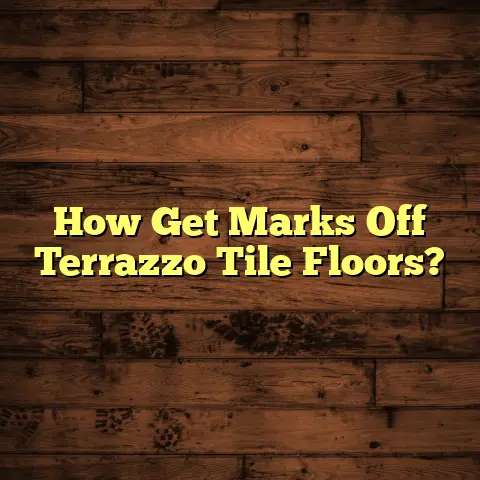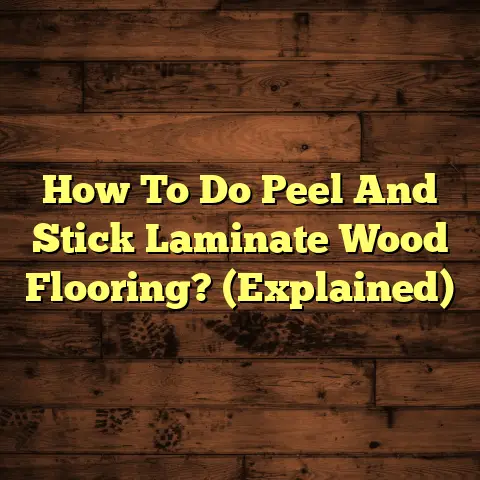Underlay for Laminate on Wood? (1 Secret Tip!)
Imagine stepping into a home where every detail whispers elegance.
The warm glow of the lighting, the tasteful décor, and, most importantly, the flooring.
Luxury flooring isn’t just about aesthetics; it’s about the feeling underfoot, the sound of your footsteps, and the overall ambiance it creates.
Laminate flooring, when done right, can absolutely achieve that luxurious feel, especially when laid over a wooden subfloor.
But here’s the thing: the secret to truly unlocking that luxurious experience lies beneath the surface – in the underlay.
And I’m going to share a secret tip with you that most homeowners overlook. Let’s dive in, shall we?
Section 1: Understanding the Basics of
Laminate Flooring
So, what exactly is laminate flooring?
Well, in simple terms, it’s a multi-layer synthetic flooring product fused together through a lamination process.
Think of it as a high-resolution photograph of wood, stone, or tile, protected by a durable wear layer and bonded to a core board.
It’s a fantastic option for homeowners seeking a beautiful, durable, and cost-effective alternative to natural materials.
Laminate’s appeal in luxury home design stems from its ability to mimic high-end materials.
Want the look of rich, dark walnut floors without the hefty price tag?
Laminate can do that.
Dreaming of a sleek, modern kitchen with the appearance of slate tiles?
Laminate’s got you covered.
There’s a vast array of styles and finishes available.
You can find laminate that perfectly replicates the texture and grain of various hardwoods, the natural variations in stone, or even the unique patterns of ceramic tiles.
Now, let’s talk about the unsung hero of laminate flooring: the underlay.
It’s the thin layer of material that sits between the subfloor (in this case, wood) and the laminate planks.
And trust me, it’s far more important than you might think.
Section 2: The Role of Underlay in
Laminate Flooring
What does underlay actually do?
It’s a multi-tasker, plain and simple.
First and foremost, it acts as a sound barrier, reducing noise transmission between floors.
Think about it: no more echoing footsteps or annoying creaks every time someone walks across the room.
This is especially important in multi-story homes or apartments where soundproofing is crucial for creating a peaceful living environment.
Secondly, underlay provides insulation, helping to regulate temperature and keep your floors warm in the winter and cool in the summer.
This can significantly reduce your energy bills and make your home more comfortable year-round.
But perhaps the most critical function of underlay is moisture protection.
Wooden subfloors are susceptible to moisture damage, and even a small amount of moisture can cause laminate flooring to warp, buckle, or even grow mold.
Underlay acts as a barrier, preventing moisture from seeping into the laminate and causing costly damage.
Beyond these practical benefits, underlay also contributes to the overall comfort of your laminate flooring.
A good underlay can provide a slight cushioning effect, making the floor feel softer and more comfortable underfoot.
This is especially noticeable in areas where you spend a lot of time standing, such as the kitchen or bathroom.
And let’s not forget about the impact on the laminate’s performance.
The right underlay can help to distribute weight evenly across the floor, preventing excessive wear and tear on the laminate planks.
This can significantly extend the lifespan of your flooring and keep it looking beautiful for years to come.
Think of it this way: the underlay is the foundation upon which your luxury laminate flooring is built.
It’s the invisible layer that supports, protects, and enhances the overall performance and comfort of your flooring.
Section 3: Types of Underlay for Laminate
Flooring on Wood
Okay, so you know why underlay is important, but what kind should you choose?
With so many options on the market, it can be overwhelming.
Let’s break down the most common types of underlay for laminate flooring on wooden subfloors:
-
Foam Underlay: This is the most common and affordable type of underlay.
It’s typically made from polyethylene or polyurethane foam and provides basic sound insulation and cushioning.
Foam underlay is a good option for budget-conscious homeowners who are looking for a simple and effective solution.
However, it’s not the best choice for areas with high moisture levels or heavy foot traffic.
-
Rubber Underlay: Rubber underlay is a step up from foam in terms of performance and durability.
It’s made from recycled rubber and provides superior sound insulation, cushioning, and moisture protection.
Rubber underlay is a great option for homes with children or pets, as it can help to absorb impact and reduce noise.
It’s also a good choice for areas with high moisture levels, such as bathrooms or kitchens.
-
Cork Underlay: Cork is a natural and sustainable material that offers excellent sound insulation, thermal insulation, and moisture resistance.
It’s also naturally antimicrobial, which makes it a great choice for people with allergies or sensitivities.
Cork underlay is a premium option that can significantly enhance the comfort and performance of your laminate flooring.
However, it’s also one of the more expensive types of underlay.
-
Combination Underlay: As the name suggests, combination underlay combines different materials to offer a range of benefits.
For example, some combination underlays feature a layer of foam for cushioning and a layer of rubber for sound insulation.
These underlays can be a good compromise between price and performance, offering a balance of benefits at a reasonable cost.
Here’s a table summarizing the different types:
| Type of Underlay | Material | Sound Insulation | Cushioning | Moisture Protection | Cost | Best For |
|---|---|---|---|---|---|---|
| Foam | Polyethylene/Polyurethane | Basic | Basic | Limited | Low | Budget-conscious homeowners |
| Rubber | Recycled Rubber | Superior | Superior | Excellent | Medium | Homes with kids/pets, high moisture areas |
| Cork | Natural Cork | Excellent | Good | Excellent | High | Allergy sufferers, premium performance |
| Combination | Varies | Good | Good | Good | Medium | Balance of price and performance |
When choosing an underlay, consider the following factors:
- Your budget: How much are you willing to spend on underlay?
- Your needs: What are your priorities in terms of sound insulation, cushioning, and moisture protection?
- Your subfloor: Is your wooden subfloor level and dry?
- The location: Where will the laminate flooring be installed?
Section 4: The Secret Tip: Choosing the
Right Underlay for a Luxurious Finish
Alright, time for the big reveal!
The secret tip for achieving the ultimate luxury feel when installing laminate flooring over wood?
It’s all about density and sound absorption.
Specifically, I recommend using a high-density rubber underlay with a sound transmission class (STC) rating of 70 or higher.
Now, I know what you’re thinking: “STC rating? What’s that?”
STC is a measure of how well a material blocks airborne sound.
The higher the STC rating, the better the sound insulation.
Most standard underlays have an STC rating of around 50-60.
But a high-density rubber underlay with an STC rating of 70 or higher can significantly reduce noise transmission, creating a much quieter and more peaceful environment.
But it’s not just about sound.
High-density rubber also provides a more substantial and luxurious feel underfoot.
It’s like walking on a cloud!
The science behind this tip is simple: denser materials absorb more sound and provide more cushioning.
High-density rubber is naturally dense and resilient, making it an ideal material for underlay.
It’s often overlooked because many homeowners focus solely on the appearance of the laminate flooring and don’t realize the impact that the underlay can have on the overall sensory experience.
I’ve seen firsthand the difference that this tip can make.
I once worked with a client who was renovating her master bedroom and wanted to create a luxurious and relaxing retreat.
She had chosen a beautiful wood-look laminate flooring, but she was hesitant to spend extra money on a high-end underlay.
I convinced her to try the high-density rubber underlay with an STC rating of 72.
And let me tell you, she was blown away by the results.
Not only did the flooring look stunning, but it also felt incredibly comfortable underfoot.
And the room was noticeably quieter, creating a more peaceful and relaxing atmosphere.
She told me that it felt like she was walking on a cloud and that she had never slept so well.
Here’s a quote from an interior designer I know:
“The underlay is the foundation of any successful flooring project. Investing in a high-quality underlay, especially when using laminate over wood, is essential for achieving a luxurious and comfortable finish.” – Sarah Miller, Interior Designer
Here are some additional benefits of using a high-density rubber underlay:
- Improved sound insulation: Reduces noise transmission between floors, creating a quieter and more peaceful environment.
- Enhanced comfort: Provides a more substantial and luxurious feel underfoot.
- Increased durability: Helps to distribute weight evenly across the floor, preventing excessive wear and tear on the laminate planks.
- Moisture protection: Protects the laminate flooring from moisture damage.
- Hypoallergenic: Resistant to mold and mildew, making it a great choice for people with allergies or sensitivities.
Section 5: Installation Process: Ensuring a
Flawless Finish
Okay, you’ve chosen your high-density rubber underlay.
Now it’s time to install your laminate flooring.
Here’s a step-by-step guide to ensure a flawless finish:
-
Prepare the subfloor: Make sure the wooden subfloor is clean, dry, and level.
Remove any debris, nails, or screws that could interfere with the installation.
If the subfloor is uneven, you may need to use a leveling compound to create a smooth surface.
-
Acclimate the laminate flooring: Allow the laminate flooring to acclimate to the room’s temperature and humidity for at least 48 hours before installation.
This will help to prevent warping or buckling after installation.
-
Install the underlay: Roll out the high-density rubber underlay over the subfloor, making sure to overlap the edges slightly.
Use a utility knife to trim the underlay to fit the room’s dimensions.
Tape the seams together with seam tape to prevent moisture from seeping through.
-
Install the laminate flooring: Follow the manufacturer’s instructions for installing the laminate flooring.
Typically, this involves interlocking the planks together at an angle and tapping them into place with a rubber mallet.
Use spacers along the walls to maintain a consistent expansion gap.
-
Install trim and moldings: Once the laminate flooring is installed, install trim and moldings around the perimeter of the room to cover the expansion gap and create a finished look.
Here are some tools and techniques that will help you achieve a professional finish:
-
Moisture meter: Use a moisture meter to check the moisture content of the wooden subfloor before installation.
The moisture content should be below 12% to prevent moisture damage to the laminate flooring. * Level: Use a level to ensure that the subfloor is level before installation.
An uneven subfloor can cause the laminate flooring to buckle or warp. * Rubber mallet: Use a rubber mallet to tap the laminate planks into place.
A metal hammer can damage the laminate flooring. * Spacers: Use spacers along the walls to maintain a consistent expansion gap.
Here are some common mistakes to avoid during installation:
- Not preparing the subfloor properly: A dirty, uneven, or moist subfloor can cause problems with the laminate flooring.
- Not acclimating the laminate flooring: Failing to acclimate the laminate flooring can cause warping or buckling after installation.
- Not using enough spacers: Not using enough spacers can cause the laminate flooring to buckle or warp.
- Not sealing the seams between the underlay: Failing to seal the seams between the underlay can allow moisture to seep through and damage the laminate flooring.
- Using the wrong tools: Using the wrong tools can damage the laminate flooring.
Section 6: Maintenance Tips for Luxury
Laminate Flooring
Congratulations!
You’ve installed your luxury laminate flooring and it looks amazing.
But the work doesn’t stop there.
To keep your flooring looking and feeling luxurious for years to come, you need to follow these maintenance tips:
-
Clean regularly: Sweep or vacuum your laminate flooring regularly to remove dirt, dust, and debris.
Use a soft-bristled brush or a vacuum cleaner with a floor attachment to avoid scratching the surface.
-
Mop occasionally: Mop your laminate flooring occasionally with a damp mop and a laminate floor cleaner.
Avoid using excessive water, as this can damage the laminate flooring.
Never use abrasive cleaners, scouring pads, or steel wool, as these can scratch the surface.
-
Wipe up spills immediately: Wipe up spills immediately with a clean, dry cloth.
Avoid letting spills sit on the surface for extended periods of time, as this can stain the laminate flooring.
-
Use mats and rugs: Place mats and rugs at entrances and in high-traffic areas to protect the laminate flooring from dirt, scratches, and wear.
-
Avoid wearing shoes with high heels: High heels can dent or scratch the laminate flooring.
Encourage guests to remove their shoes or wear soft-soled shoes.
-
Protect from sunlight: Prolonged exposure to direct sunlight can fade the laminate flooring.
Use curtains, blinds, or window film to protect the flooring from sunlight.
-
Check for moisture: Regularly check for moisture around the perimeter of the room, especially in areas prone to leaks or spills.
Address any moisture problems immediately to prevent damage to the laminate flooring.
Different underlays can impact maintenance routines.
For example, cork underlay is naturally antimicrobial and resistant to mold and mildew, making it a good choice for people with allergies or sensitivities.
Rubber underlay is more resistant to moisture than foam underlay, making it a better choice for areas prone to spills or leaks.
Here are some seasonal care tips for laminate flooring:
-
Winter: During the winter months, the air can become very dry, which can cause the laminate flooring to shrink.
Use a humidifier to maintain a consistent humidity level in your home.
-
Summer: During the summer months, the air can become very humid, which can cause the laminate flooring to expand.
Use air conditioning or a dehumidifier to maintain a consistent humidity level in your home.
Conclusion: Elevating Your Space to New
Heights of Luxury
So, there you have it!
The secret to unlocking the ultimate luxury feel when installing laminate flooring over wood lies in choosing the right underlay.
By investing in a high-density rubber underlay with a high STC rating, you can significantly enhance the comfort, sound insulation, and durability of your flooring.
Don’t underestimate the power of what lies beneath!
It’s the foundation upon which your luxury flooring is built.
Take the plunge and transform your space into a luxurious haven that you’ll love coming home to every day.
You now have the knowledge to make informed decisions and create a space that reflects your personal style and elevates your everyday living experience.
Go ahead, step into a world of luxury and comfort.
Your feet (and your ears) will thank you for it!





